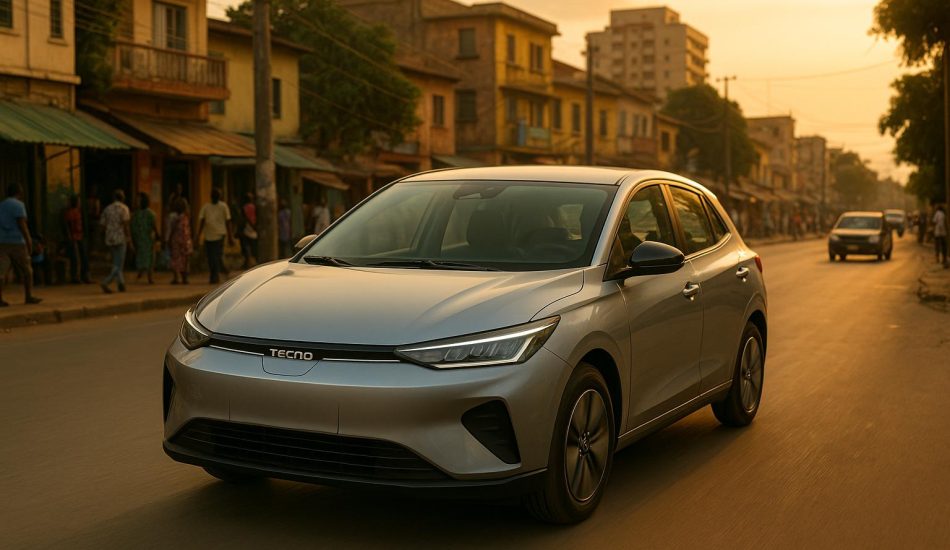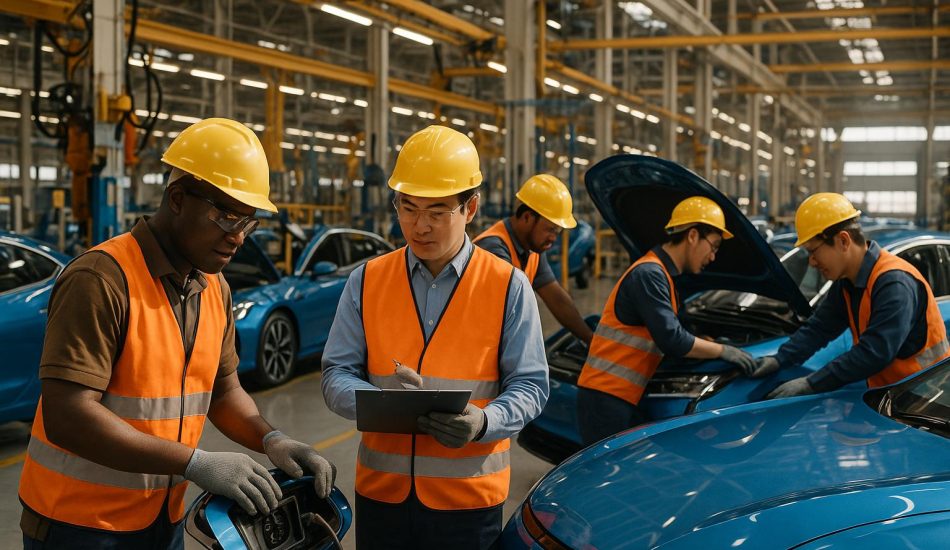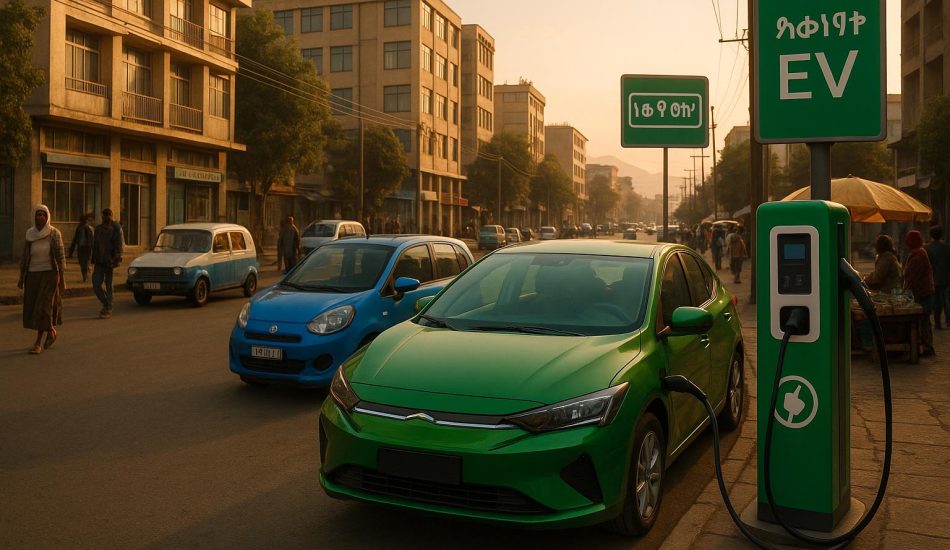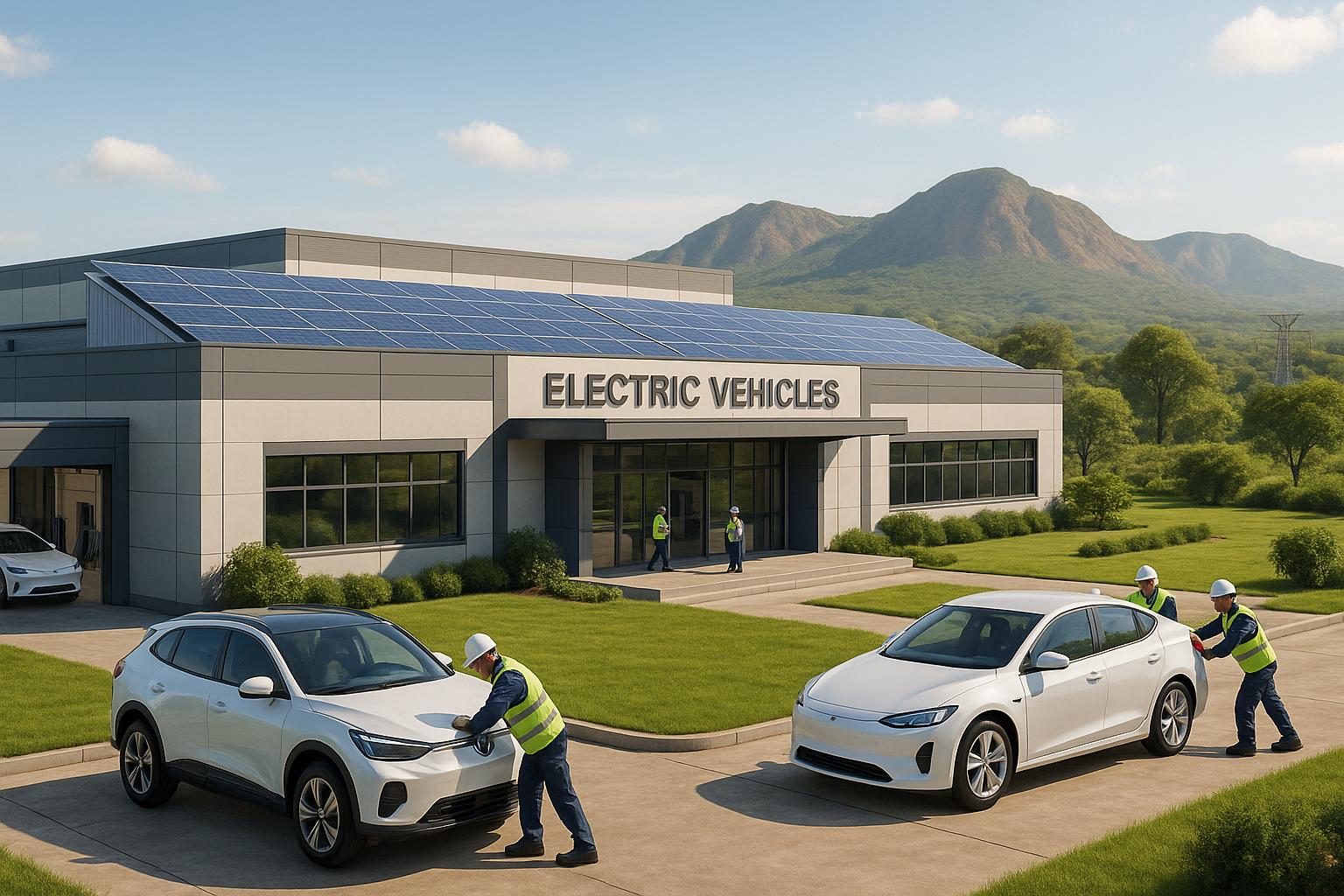
Zambia and DR Congo are creating special economic zones (SEZs) to lead Africa’s electric vehicle (EV) manufacturing efforts. These zones aim to transition both nations from exporting raw minerals to producing EV batteries and vehicles locally. Here’s what you need to know:
- Why It Matters: Zambia and DR Congo hold 70% of the minerals essential for EVs, including cobalt, copper, and lithium. Their shift to local production could significantly impact global EV supply chains.
- Key Projects: The Musompo SEZ in DR Congo ($200M budget) and a cross-border SEZ with Zambia focus on manufacturing battery precursors and EV components. Together, these projects are expected to attract billions in investments and create thousands of jobs.
- Global Context: The EV market is set to grow from $8.8 trillion in 2025 to $46 trillion by 2050. Africa’s participation in this market could boost its GDP by 12% or more by 2050.
- Support: Backed by Afreximbank, UNECA, and ARISE Integrated Industrial Platforms, these initiatives include tax incentives, infrastructure upgrades, and skills training programs to attract investors.
This collaboration positions Zambia and DR Congo as emerging leaders in EV manufacturing, leveraging their mineral wealth and strategic location to integrate into global supply chains.
Why Zambia and DR Congo Are Ideal for EV Manufacturing
Rich Deposits of Cobalt and Lithium
Zambia and the Democratic Republic of Congo (DRC) are sitting on a treasure trove of minerals essential for electric vehicle (EV) production. The DRC, for instance, leads the world in cobalt reserves, a critical material for battery manufacturing. Meanwhile, Zambia plays a pivotal role in supplying copper, another key component in EV production.
With the global shift toward EVs gaining momentum, the demand for these minerals is skyrocketing. The International Energy Agency estimates that the need for minerals used in clean energy technologies could grow more than fourfold by 2040. Beyond cobalt, the DRC also boasts about 60% of the world’s lithium reserves. Together, these mineral riches make the two countries central players in the EV supply chain, as cobalt and lithium are indispensable for lithium-ion batteries.
The significance of these resources has drawn major international investments. For instance, on May 6, 2025, KoBold Metals – a company backed by Bill Gates and Jeff Bezos – announced a $1 billion investment to acquire AVZ Minerals‘ stake in the Manono lithium deposit in the DRC. Additionally, plans for a plant in the region to produce 100,000 tons of NMC (nickel, manganese, cobalt) precursors annually highlight the manufacturing potential. This facility alone would require 48,000 tons of nickel, 15,000 tons of manganese, and 16,000 tons of refined cobalt sulfate.
These abundant resources form a solid foundation for the economic and logistical advantages discussed below.
Geographic and Economic Position
The geographic location of Zambia and the DRC offers unique opportunities for collaboration in EV manufacturing. Together, these nations account for 11% of the world’s copper supply. By working together, they can combine their strengths and streamline the value chain for battery precursors and EV production.
Their partnership also opens doors to enhanced regional trade and logistics. Leveraging the African Continental Free Trade Area (AfCFTA), these nations can promote the exchange of processed battery materials across the continent. Projections suggest that intra-African commerce in vehicles and transport equipment could grow by nearly 85% by 2045.
Moreover, this collaboration positions Zambia and the DRC to serve not just their domestic markets but also neighboring countries that are increasingly adopting EVs. This growing demand could help achieve the economies of scale necessary for competitive manufacturing.
In April 2023, a framework agreement was signed between the African Export-Import Bank (Afreximbank), the United Nations Economic Commission for Africa (ECA), and the two countries to establish Special Economic Zones (SEZs). ARISE Integrated Industrial Platform was selected as the technical consultant for this initiative.
Government and Financial Support
The mineral wealth of Zambia and the DRC is complemented by proactive government policies and international financial backing, which are driving the SEZ projects forward. Both governments have introduced reforms and financial incentives to encourage EV manufacturing. Zambia, for example, has removed all taxes on electric vehicles except for VAT and has waived VAT entirely for EVs manufactured locally.
"Our government has removed all taxes on electric vehicles, except the VAT. We have also eliminated the VAT on EVs if these vehicles are manufactured locally. Additionally, our government has committed to ensuring that at least 50% of its fleet comprises electric vehicles. This policy shift is not just a financial incentive; it is a declaration of our commitment to fostering a green economy and promoting sustainable industrialization."
– Chipoka Mulenga, Zambia’s Minister of Commerce, Trade, and Industry
The DRC is also stepping up its efforts. President Félix Tshisekedi has established the Congolese Battery Council to oversee the development of the battery industry, formalized through a presidential decree. Additionally, the Musompo SEZ in the Lualaba province is expected to cost over $200 million, with support from Afreximbank and the ECA.
"We shall assess readiness, identify key action points, chart a path towards successful implementation with clear timelines and tangible targets. Moreover, we will deliberate on mechanisms for collaboration among stakeholders."
– Ms. Oluranti Doherty, Director of Export Development at Afreximbank
The potential for growth is immense. The global battery electric vehicle market is projected to reach $8.8 trillion by 2025 and an astounding $46 trillion by 2050. Meanwhile, Africa’s automotive industry is expected to grow by 40%, hitting $42.06 billion by 2027.
"Adding value to the battery minerals, through an inclusive and sustainable industrialisation, will definitely allow the two countries to pave the way to a robust, resilient and inclusive growth pattern which creates jobs for millions of our population and mostly the young people whose capacity will be strengthened by the African center of excellence on electrical batteries skills launched last week in Lubumbashi, as a partnership between Congolese and Zambian schools of mines and polytechnics."
– Mr. Jean Luc Mastaki, Director a.i. for ECA Sub-Regional Office for Central Africa
Current Projects and Features in the SEZs
Musompo SEZ in Lualaba, DRC
The Musompo Special Economic Zone (SEZ), situated in Lualaba – a province rich in cobalt – covers an impressive 2,200 acres (about 900 hectares). With a development budget exceeding $200 million, this SEZ is designed to oversee the entire electric vehicle (EV) battery supply chain. Its scope includes manufacturing battery precursors, producing batteries, and potentially assembling electric vehicles using locally sourced raw materials. The project is expected to attract $2 billion in investments and generate more than 85,000 jobs in total. By 2024, Lualaba’s installed capacity reached 847.2 MW, and tax and customs exemptions have been implemented to further entice investors. This initiative aims to position the Democratic Republic of Congo (DRC) as a major player in the global EV supply chain by 2035–2040.
Cross-Border SEZ Projects
In addition to flagship initiatives, regional collaborations are strengthening the EV manufacturing ecosystem. One standout effort is the Zambia–DRC cross-border SEZ, which takes a unique transboundary approach. This strategy integrates the mineral resources of both nations to create a cohesive manufacturing network. In March 2023, ARISE Integrated Industrial Platforms conducted a pre-feasibility study, which was later reviewed in a technical meeting organized by the Economic Commission for Africa (ECA) and Afreximbank. By December 2023, a draft report was submitted to both governments for feedback.
The cross-border SEZ focuses on producing nickel, manganese, and cobalt (NMC) battery precursors – key components for EV batteries. This approach not only reduces costs but also offers environmental advantages over traditional manufacturing methods. Eunice Kamwendo, Director of the UNECA Office for Southern Africa, highlighted the project’s transformative potential, stating it represents "an immense opportunity for transforming regional economies and the entire continent through mineral-based development". This integrated model paves the way for public-private partnerships to drive industrial growth across the region.
Public-Private Partnerships
A 2023 framework agreement between Afreximbank, UNECA, and the governments of the DRC and Zambia serves as the foundation for these transformative projects. This agreement focuses on turning raw mineral exports into EV manufacturing hubs. Afreximbank plays a dual role, providing financial support and shaping industrial strategies. Ms. Oluranti Doherty, Afreximbank’s Director of Export Development, emphasized:
"At Afreximbank, we are firmly convinced that Industrial Parks and Special Economic Zones are critical tools the continent can deploy to fast-track its industrial infrastructure development, promote Intra-African Trade, accelerate the implementation of the AfCFTA and facilitate Export Development, and the execution of this framework agreement testifies to a strong commitment by the governments of the DRC and Zambia, Afreximbank and ECA, as well as other partners, to promote inclusive development of the Battery Electric Vehicle value chain, also rendering the DRC and Zambia globally competitive investment destinations".
ARISE Integrated Industrial Platform brings its technical expertise to the table, helping to develop this intricate ecosystem. Antonio Pedro, interim Executive Secretary of the ECA, described these partnerships as "an important step in ensuring we have the right enabling policies in place for the region to benefit from the so-called green mineral boom". With the global battery electric vehicle market projected to reach $8.8 trillion by 2025 and an astounding $46 trillion by 2050, these partnerships are vital for Africa’s shift toward sustainable, value-added production in the EV sector.
Economic Impact of SEZs in Africa
Job Creation and Skills Training
Special economic zones in Zambia and the Democratic Republic of Congo (DRC) are paving the way for job creation across various skill levels. These opportunities extend well beyond basic manufacturing, offering high-skilled roles in areas like engineering, quality control, and technical management. A great example of this progress is the TASEZ Academy, which trained 526 young people from local communities in 2024, focusing on critical skills in safety, health, environmental, and quality standards for the automotive industry. This initiative is especially vital given South Africa’s youth unemployment rate of 62.4% among those aged 15–24.
The academy isn’t stopping there. It has also allocated funding for 40 engineering degrees, 20 master’s degrees, and 10 PhDs, aiming to develop local expertise and foster technical leadership. On top of that, innovation and incubation hubs for clean energy are helping engineers, technicians, and entrepreneurs gain the technical skills needed to thrive in this growing sector. These efforts are all part of a broader push to establish a competitive electric vehicle (EV) supply chain while supporting industrialization within SEZs.
Adding Value to Mineral Resources
Africa has a golden opportunity to transform its economy by processing minerals locally instead of exporting them as raw materials. Sub-Saharan Africa holds around 30% of the world’s proven reserves of critical minerals, yet it only captures about 40% of the potential revenue from these resources. The difference in value is staggering: raw bauxite, for instance, sells for just $92 per ton, while its refined form commands $2,438 per ton.
When it comes to minerals essential for EVs, the stakes are even higher. The DRC produces over 70% of the world’s cobalt and holds nearly half of the global reserves, but it exports 97% of this cobalt in unprocessed form, primarily to China. With global revenues from minerals like copper, nickel, cobalt, and lithium projected to reach $16 trillion over 25 years, Africa could capture more than 10% of this total – potentially boosting GDP by 12% or more by 2050. As Nalituba Mwale, Director of Administration at Zambia’s Ministry of Commerce, Industry, and Trade, stated:
"Zambia and the DRC are home to at least 70% of the minerals needed to realize this vision".
By building industries to process these critical minerals into higher-value products, Africa can not only drive industrial growth but also expand energy access and reduce its dependence on volatile commodity prices. Shifting from raw exports to value-added production is a cornerstone of Africa’s industrial transformation.
This approach also strengthens Africa’s role in global supply chains. Here’s a quick look at some key minerals and their uses:
| Mineral | Africa’s Share of Global Reserves | Major African Producers | Primary EV Use |
|---|---|---|---|
| Cobalt | 47% | Democratic Republic of Congo | Lithium-ion batteries for EVs and energy storage |
| Manganese | 85% | South Africa, Gabon | Steel production, batteries, and fertilizers |
| Chromium | 80% | South Africa | Stainless steel, pigments, and refractory materials |
| Platinum Group Metals | 80% | South Africa, Zimbabwe | Fuel cells for hydrogen-based energy systems |
| Graphite | 21% | Madagascar, Mozambique, Tanzania | Lithium-ion batteries and energy storage systems |
Supporting Africa’s Clean Transportation Goals
SEZs are also playing a crucial role in advancing clean transportation. The rapid expansion of the electric vehicle market presents Africa with a unique chance to establish itself early in the supply chain. By refining minerals locally, the continent can move beyond raw exports and capture significantly more value.
Recent developments highlight this momentum. In December 2024, the UN Economic Commission for Africa hosted a workshop to strengthen regional value chains for electric mobility in the DRC, Morocco, and Zambia. One key outcome was the push for a Memorandum of Understanding among these countries in 2025, which would integrate Morocco into the Zambia-DRC SEZ. Additionally, in June 2023, Morocco signed a $6.4 billion deal with Chinese battery maker Gotion High-Tech Co to build an EV battery factory in the Rabat-Salé-Kénitra region, with a planned annual production capacity of 100 gigawatts.
The environmental benefits of this transition are undeniable. Electric vehicles are about 50% better for the environment compared to traditional gas-powered cars. As Damilola Ogunbiyi, CEO and Special Representative of the UN Secretary-General for Sustainable Energy for All, put it:
"Green value chains sit at the heart of developing countries’ priorities to advance energy access and security, climate action and industrialization. Governments increasingly recognize that the energy transition must go hand-in-hand with efforts to build domestic renewable energy manufacturing capacity to capitalize on the socio-economic opportunity."
Ngozi Okonjo-Iweala, Director-General of the World Trade Organization, echoed this sentiment:
"This is a time for us to make sure we are part of the supply chains for these new products. And we’ve got the minerals that are actually looked for, many of them are on the continent. I think Africans really need to this time, in a concerted fashion, make a case for the part of this supply chain for electric-powered vehicles that everybody is trying to manufacture."
Challenges and Opportunities: Zambia vs DR Congo
Comparison Table: Zambia vs DR Congo SEZs
Zambia and DR Congo bring different strengths and challenges to the table when it comes to developing Special Economic Zones (SEZs) for electric vehicle (EV) manufacturing. For investors and policymakers, understanding these contrasts is essential to fully tap into the potential of this cross-border initiative.
| Factor | Zambia | DR Congo |
|---|---|---|
| Key Mineral Resources | Copper (820,000 metric tons in 2024) and increasing nickel production | Cobalt (70% of global supply), copper, lithium |
| Infrastructure Development | $1 billion Lobito Corridor rail project, reducing export costs by 30% | Limited transport infrastructure but vast hydropower potential |
| Energy Supply | 80% hydroelectricity, though prone to drought-related blackouts | Abundant hydropower resources |
| Investment Climate | Regulatory reforms for mining sector stability and tax certainty | Improved credit ratings: S&P upgraded to B‑, Stable (Jan 2022); Moody’s to B3, Positive (Nov 2022) |
| Manufacturing Costs | Expertise in copper processing | Battery production emits 30% less greenhouse gases than in China; cathode plant costs are about three times lower than in the US |
| Proposed SEZ Locations | Sub-Sahara Gemstone Exchange Industrial Park | Kinsevere for precursor plant development |
This comparison highlights the unique opportunities and challenges each country faces, setting the stage for a deeper look at how collaboration can enhance their EV manufacturing potential.
Regional Collaboration Opportunities
Given their individual strengths and challenges, regional collaboration between Zambia and DR Congo is a game-changing strategy for building Africa’s EV ecosystem. By working together, both nations can leverage their respective advantages to create a more integrated and efficient supply chain.
The partnership between Zambia’s copper production expertise and DR Congo’s dominance in cobalt offers a powerful combination. Together, these two nations contribute 11% of the global copper supply, positioning them as critical players in the EV materials market.
Infrastructure projects like the $1 billion Lobito Corridor rail project and the completed prefeasibility study for the Transboundary SEZ demonstrate the potential of aligning efforts. These initiatives streamline logistics, improve investment appeal, and ensure regulatory and policy frameworks are in sync.
There’s also significant promise in technology transfer. DR Congo’s capacity for low-emission battery production, combined with Zambia’s growing skills in copper processing, creates an ideal environment for partnerships with international battery manufacturers like CATL and LG Energy Solution.
Finance Minister Situmbeko Musokotwane emphasized Zambia’s proactive stance in attracting international investment:
"We have been talking, even last week when I was in Germany, telling these companies to please consider the manufacture of some of your electric vehicle components in Zambia".
The timing couldn’t be better. The battery electric vehicle market is projected to grow from $8.8 trillion in 2025 to a staggering $46 trillion by 2050. This six-fold increase offers a massive opportunity for Zambia and DR Congo to solidify their roles in the global EV supply chain.
Lastly, this collaboration enhances supply chain resilience. By spreading mineral processing and battery production across two nations, the partnership reduces risks for international manufacturers. This diversification is a critical advantage in creating a more robust and reliable global supply chain.
sbb-itb-99e19e3
Zambia Just Made a Move That Could Change the EV Industry FOREVER!
The Future of EV Manufacturing in Africa
Africa is positioning itself as a major player in the global electric vehicle (EV) market, thanks to the rise of special economic zones (SEZs) in countries like Zambia and the Democratic Republic of Congo (DRC). These SEZs are set to play a pivotal role as the battery electric vehicle market surges from $8.8 trillion in 2025 to an estimated $46 trillion by 2050, creating a massive economic opportunity for the continent.
The African automotive industry is already seeing rapid growth, with projections indicating a 40% increase, reaching $42.06 billion by 2027. When coupled with the African Continental Free Trade Area (AfCFTA), which could increase intra-African trade in vehicles and transport equipment by nearly 85% by 2045, Africa’s potential to dominate EV manufacturing becomes clearer.
These SEZs are also hubs for cutting-edge technology, incorporating tools like digital twins, advanced robotics, AI-driven quality control, and sustainable practices. The global market for power electronics in EVs alone is expected to hit $36 billion by 2035, growing at a compound annual rate of 17% between 2025 and 2035.
"presents an immense opportunity for transforming regional economies and the entire continent through mineral-based development. With a shift from internal combustion to electric vehicles, the battery electric vehicle market is poised to grow to $8.8 trillion by next year, 2025, and $46 trillion by 2050 – a nearly six-fold increase in market value over the next 25 years."
- Eunice Kamwendo, Director of the ECA Office for Southern Africa
Key Points Driving Africa’s EV Industry
The investments in SEZs are not just about immediate economic gains – they’re laying the groundwork for long-term growth and efficiency in Africa’s EV manufacturing sector. Here are some of the standout advantages:
- Cost-efficient manufacturing: Setting up precursor facilities in the DRC is significantly cheaper – three times less expensive than in the U.S. – with total SEZ setup costs estimated at $2.7 billion.
- Lower environmental impact: Battery production in the DRC generates 30% fewer greenhouse gas emissions compared to similar operations in China.
- Value chain shift: Africa is moving from exporting raw minerals to producing finished EV components and batteries locally.
- Job creation: Thousands of new manufacturing jobs are being created, along with the development of technical expertise in battery production and EV assembly.
- Global collaboration: Trilateral agreements and international partnerships are fueling these projects, showcasing global support for Africa’s ambitions.
"This is a time for us to make sure we are part of the supply chains for these new products. And we’ve got the minerals that are actually looked for, many of them are on the continent. I think Africans really need to this time, in a concerted fashion, make a case for the part of this supply chain for electric-powered vehicles that everybody is trying to manufacture."
- Ngozi Okonjo-Iweala, Director-General, World Trade Organization
EV24.africa: Connecting the Dots in Africa’s EV Ecosystem
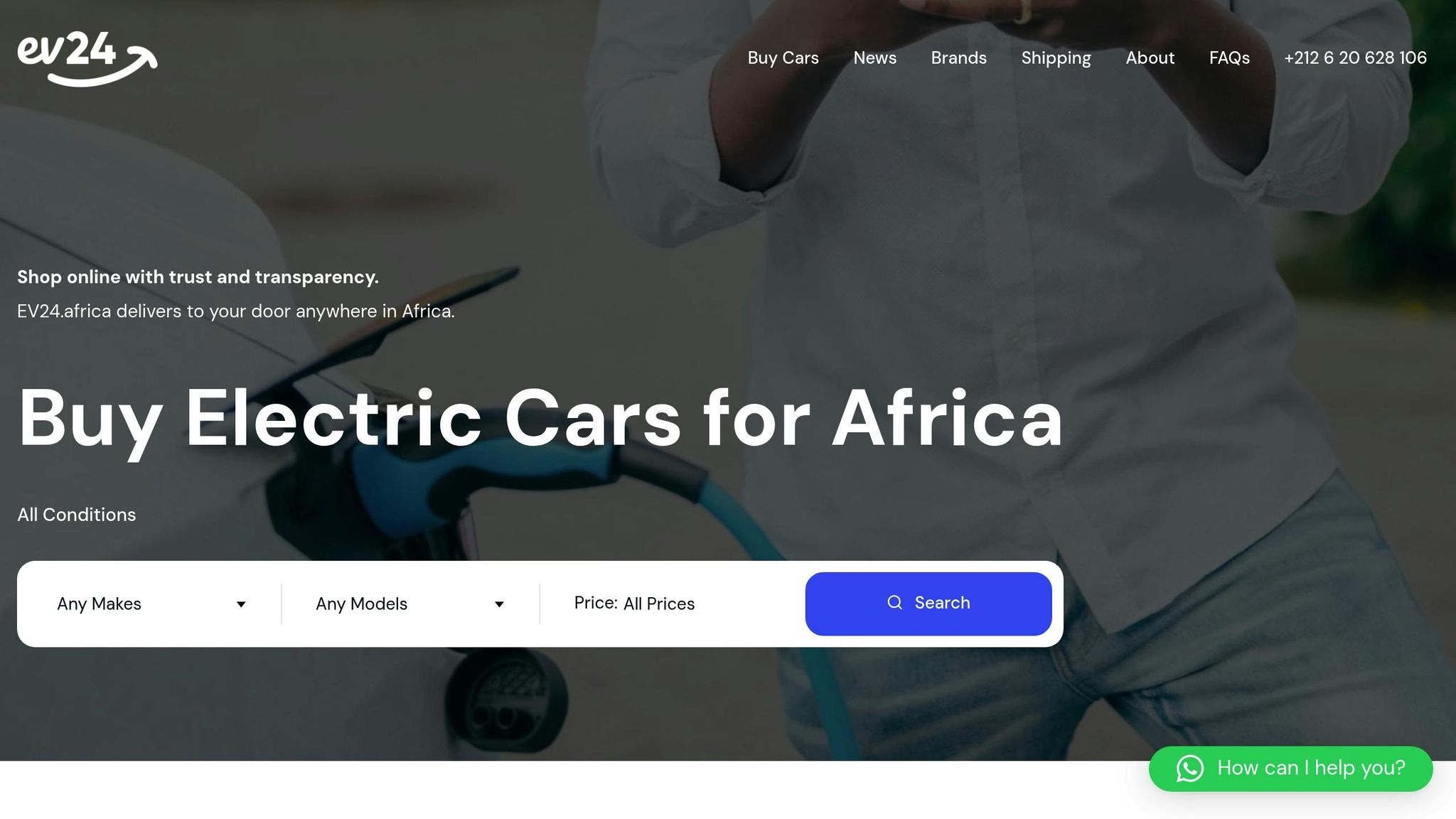
As Africa’s EV manufacturing capabilities grow, platforms like EV24.africa are stepping in to bridge the gap between production and demand. By offering a comprehensive marketplace spanning all 54 African countries, EV24.africa ensures that locally manufactured EVs find their way to consumers across the continent.
The platform provides access to EVs from leading brands like Tesla, BYD, and Leapmotor, with transparent pricing and financing options tailored to African buyers. This integrated approach not only supports the SEZ objectives but also ensures that the economic benefits of EV manufacturing stay within the region.
"We have been talking, even last week when I was in Germany, telling these companies to please consider the manufacture of some of your electric-vehicle components in Zambia."
- Situmbeko Musokotwane, Finance Minister of Zambia
FAQs
What advantages do Special Economic Zones (SEZs) in Zambia and DR Congo bring to the global electric vehicle (EV) industry?
Special Economic Zones (SEZs) in Zambia and DR Congo: A Boost for the Global EV Industry
Zambia and DR Congo are making waves in the global electric vehicle (EV) industry through their Special Economic Zones (SEZs). These zones leverage the region’s rich reserves of essential materials like cobalt, lithium, and manganese – key ingredients in EV batteries. By focusing on local manufacturing of batteries and EV components, these SEZs aim to cut reliance on imports while encouraging greater self-sufficiency within the region.
But the benefits don’t stop there. SEZs are also magnets for foreign investment, creating jobs and fostering cross-border partnerships. This collaborative approach helps streamline supply chains and makes better use of resources. With these efforts, Africa is carving out a crucial role in the shift toward sustainable mobility and the expanding global EV market.
Why are Zambia and DR Congo well-positioned to lead in EV manufacturing?
Zambia and DR Congo hold a wealth of critical minerals such as cobalt, copper, manganese, and nickel – all vital components in the production of EV batteries. These natural resources place the two nations at the heart of the global EV supply chain.
By tapping into their rich mineral reserves and setting up special economic zones, Zambia and DR Congo are boosting local manufacturing, drawing in investments, and encouraging advancements in the EV sector. This progress strengthens their role as key contributors to the shift toward cleaner transportation, not just in Africa but on a global scale.
What obstacles do Zambia and DR Congo face in shifting from exporting raw minerals to manufacturing EV batteries and vehicles locally?
Zambia and DR Congo are navigating a complex path as they aim to shift from exporting raw minerals to producing electric vehicle (EV) batteries and vehicles locally. A significant obstacle in this transition is the lack of advanced infrastructure. Building manufacturing plants and establishing reliable energy systems will require substantial investment – something that doesn’t happen overnight.
Another challenge lies in bridging the gap in technical expertise. Developing the skills needed to support this new industry is no small feat. On top of that, both nations must establish strong regulatory frameworks to ensure the industry can grow sustainably and efficiently.
Investment, both foreign and domestic, will play a crucial role in building a competitive EV manufacturing sector. But this isn’t just about money – regional cooperation and responsible resource management are equally important. Without careful planning, mining and production could lead to environmental damage or social conflicts, undermining progress.
Tackling these hurdles is essential for Zambia and DR Congo to fully capitalize on their abundant natural resources and boost their economies through this promising industry.


